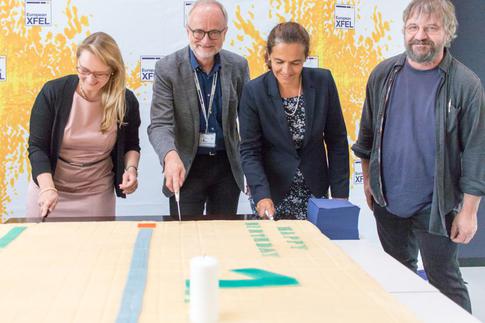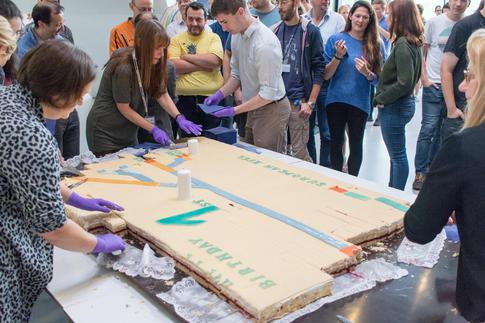XFEL: European XFEL celebrates one year of user operation
European XFEL celebrates one year of user operation

DESY and European XFEL staff celebrate one year of user operation. l to r: European XFEL Managing Directors Nicole Elleuche and Robert Feidenhans'l, European XFEL Council Chair Maria Faury and DESY Accelerator Scientist Dirk Noelle.
At the beginning of September, staff and users of the world’s largest X-ray laser facility celebrate a successful first year of user operation. Since September 2017, over 500 scientists from more than 20 countries from across the globe have visited European XFEL in Schenefeld in north Germany for their week long experiments. The first research results were published just days ago on 28 August; more publications are in preparation for the following weeks.
For the first and second round of experiments scheduled from September 2017 to October 2018, 123 international groups of scientists submitted their proposals for experiment. Of these, 26 groups were selected by an international panel of experts to carry out their research at the two instruments—the SPB/SFX instrument (Single Particles, Clusters and Biomolecules / Serial Femtosecond Crystallography) and the FXE instrument (Femtosecond X-Ray Experiments). The experiments range from method development to biomolecule structure determination and studies of extremely fast processes in small molecules and chemical reactions. Submissions for the user experiments at the remaining four instruments scheduled to start operation between the end of 2018 and mid-2019 are currently being evaluated.

DESY and European staff celebrate one year of user operation with birthday cake at the facility in Schenefeld. Copyright: European XFEL
Since the start of operation, DESY and European XFEL staff has continually increased the performance of the X-ray laser. In July, the European XFEL accelerator reached its design energy, for the first time accelerating electrons to the energy of 17.5 GeV (a giga electron volt equates to 1000 million electron volts), thereby enabling the production of detailed images and film of the atomic structure of matter. While the first users were able to use up to 300 X-ray pulses per second for their experiments, users now have access to 1200 pulses a second. This means that European XFEL can already deliver ten times as many X-ray pulses per second as any other X-ray facility worldwide. This has many advantages including enabling faster data collection. Further improvements and developments at the facility include components installed at the instruments that have optimised and automated the experiments and data collection.
Prof. Robert Feidenhans’l, managing director of European XFEL: “I am very pleased with our achievements over the last year. There are still a lot of challenges to meet every day, but in just one year we have run successful experiments together with our users, collected some very interesting data, and even had the first published paper from a user experiment. Our accelerator has reached its design energy and it is impressive to see how fast data are collected and stored using the high number of X-ray pulses our facility produces per second. These are great results in which many dedicated people were involved. We could not have asked for more!”
